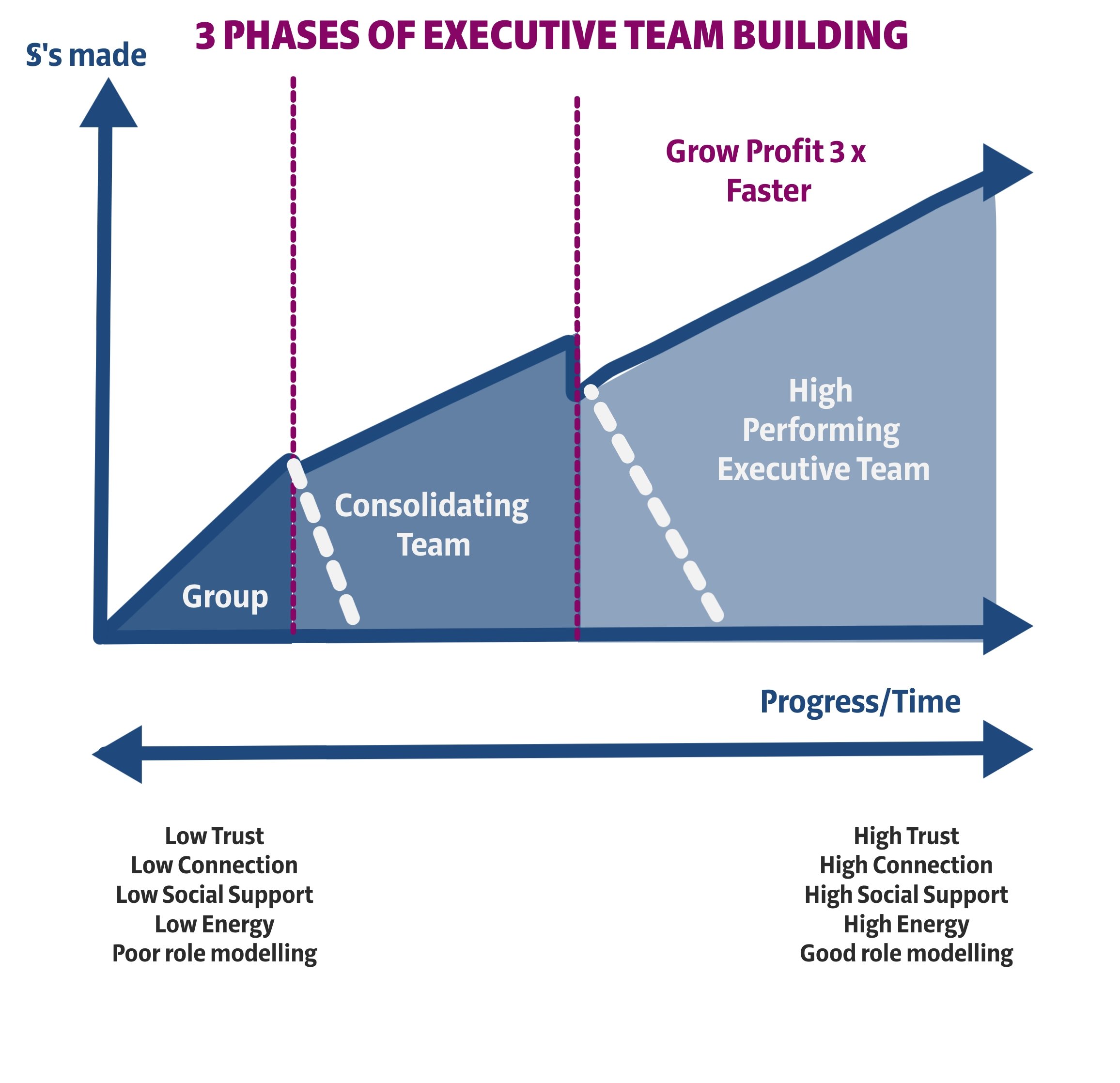
Everything is a product of evolution. Businesses go through cycles and need the right executives working at the right level for the business at that time. This comes...
To continue to grow and solve today’s tricky business challenges, requires organisations to adopt new ways of working, in order to stay relevant. Unlocking the value by enabling cross-functional collaboration; between finance, HR, marketing, sales, operations and technology and so on, enables cultural agility. The first place to start is with the C suite.
Leadership teams are force multipliers. Their collective impact is far greater than the CEO alone, or even individual contributions by team members, on the long-term success of their organisation. According to McKinsey research, leadership teams are so critical because they have much broader and deeper reach than the CEO. A high-performing team engenders organisational coherence and focus that is more likely to maximise potential. While a poorly performing team fosters competing agendas, unproductive conflict and a lack of accountability.
Poor leadership teams negatively impact an organisation’s ability to:
High performing leadership teams rarely develop by accident. Typically, the CEO selects executive team members based on individual performance, not on how each member will interact as an equal group of peers responsible for the entire organisation’s strategy and operations. The number one challenge becomes transitioning leaders from their own functional area to an enterprise wide perspective. Without careful monitoring, leadership teams create organisational bottlenecks characterised by silo thinking, slow decision making and finger pointing. Such dysfunctional behaviours reduces the ability to harness the collective intelligence of the team itself and the people below that report to them.
As executives model the behaviours that form the organisational culture, any weaknesses with how the C-Suite work together are likely to be amplified and manifested throughout the firm.
So how do you create a high performance executive team?
Here are five steps to get you started:
Most organisations have deeply embedded processes and habits formed over time where leadership team interactions appear fit for purpose and workable. Just like fish don’t know they are swimming in water, most CEOs and senior leaders feel that their management team is okay and have trouble seeing negative behaviours. Most team members go about their day to day activities with very little thought about how their leadership team can be improved.
That is, until meetings become stale and are characterised by poor quality decision making, conflict avoidance or highly vocal leaders using the meetings as a platform to drive their agenda at the expense of everyone else.
Even then, it takes a courageous CEO or executive to voice their concerns and try and do something about it. In our experience, we find it is leaders who value continuous improvement and who are fearful that poor leadership team behaviours are putting the organisation at competitive risk.
Without a burning platform for change, it’s pretty difficult to convince other senior team members to modify leadership team interactions. So savvy leaders need to help their peers reconsider their viewpoint by providing new evidence that shows them persuasively that they’re false. There are three options to convince the C-Suite that change is required.
First, provide leaders with examples of best-in-class practices of other executive teams followed by a discussion of what can be done to improve the team’s performance.
Second, get every team member to undertake a team assessment, to see where the gaps are in behaviours and where improvements can be made. Armed with a greater understanding of the issues that support or sabotage performance, executives will be more open to brainstorming solutions.
Third, combine both best-in-class practices with team results followed by designing the best plan forward to better align resources.
In our experience, we find the third approach works the best. We use the SUCCEeD Together Trust Framework online assessment. Typically, leadership results are presented at a strategy offsite together with best practices/situational context and an action plan to get executives to work out the way forward. Such a workshop provides a safe space for leaders to talk about the difficult stuff and all of the little things that have been frustrating them. In fact, most leaders feel more positive about their peers and relieved that others are feeling the same way after a frank discussion. Topics that had been taboo are suddenly on the table with everyone carefully contributing their considered point of view for the betterment of the organisation.
Generally, after this type of workshop, leaders are in agreement that changes need to be undertaken and are committed to working differently moving forward.
According to Google at Work’s seminal study on what makes a high performance team, it doesn’t matter so much who is on the team, but how they interact together. This all starts with team leaders who model high-trust behaviours. Even when leaders are not around and the team meets without them, high-trust behaviours are still undertaken because the team copies what the leader does, creating a virtuous cycle of high performance.
Paul Santagata, Head of Industry at Google said, “Individuals on teams with high trust bring in more revenue, are less likely to leave Google, are more likely to harness the power of diverse ideas from their teammates and are rated as effective twice as often by executives. There is no team without trust.”
Of course, trust is a pretty airy-fairy concept on its own. In the work that we do, we define it as:
The ability for everyone in an organisation to confidently rely on (and predict) that others will do the right thing and make good on their promises.
Trust is the foundational element of all high performance relationships. Without it, leadership teams don’t engage in truth-seeking conversations about performance and behavioural issues. Instead, you’ll find that team members avoid confrontation, defend their viewpoints rather than listen to others and pass blame. When leaders aren’t talking about the difficult stuff, it means they can’t fix the really deep challenges that sabotage growth and change.
One of the first steps to building trust involves the executive team having a frank discussion about what trust looks like for the team and how each member likes to work and receive communication. This involves producing a “team purpose” document to outline how the team needs to work in terms of behaviours, expectations, interdependencies and attitudes (read more tips in 5 Steps for your Executive Team to Build Trust with Each Other).
Senior executives bring their expertise and knowledge to their roles – but also their blind spots and biases. The importance of self-awareness (possessing an accurate view of your skills, abilities, and shortcomings, as well as understanding how other people perceive your behaviour) is critical for leaders who can adapt with the times.
Research by Korn-Ferry found that a company’s financial performance is related to the level of self-awareness of the leadership team. One key finding was that for poor-performing companies’ professionals were 79 percent more likely to have low overall self-awareness than those at firms with a robust rate on return.
To be a high performance leadership team requires that each team member is willing to look honestly at their own behaviours, seek feedback and make changes. Typically, most executives get shocked when they learn that others see them showing up differently to what they think.
360 degree surveys are a great tool for leaders to learn about themselves (and for others to see their reaction to their results). In our experience, relationships among executives are strengthened when team members strive to understand how others see them and try to do something about it. It is when leaders refuse to believe that their behaviours are detrimental and won’t make changes that causes the most issues in a team.
Ultimately, how the team functions is a result of how the CEO manages and develops the team. This is an ongoing process that never stops. While this starts with having the “right people on the bus” – how they work and think together is critical. This all starts with creating an environment where team members know they can be themselves, take risks and make mistakes and they won’t get penalised by the group.
CEOs also need to encourage their executives to understand that success is all about the team winning together and not individuals. This means taking a stand against behaviours that work against the team functioning as a high performance collective.
Furthermore, it requires a humble CEO willing to model the right behaviours by being open to being challenged, admitting mistakes, listening intently and avoiding assuming negative intent.
One system to improve psychological safety is how meetings are run as it cultivates team discipline. Team leaders need to facilitate engaging meetings where everyone has an equal turn in conversations and are encouraged to report lots of errors (and fix them as a group). These types of meetings must demand accountability and listen to all viewpoints. This requires embedding routines into team meetings that build trust, not reduce it. The good news is that such meetings generate deeper insights about the industry landscape and internal shortfalls, so that the organisation can more rapidly innovate and scale new ideas.
“Organisations learn only through individuals who learn.” Peter Senge, MIT
To grow an organisation demands that the people within in it are growing. In a rapidly changing world, the business landscape is increasingly unpredictable and lessons of experience can easily put us on the wrong path. We can no longer rely on what we think we know, we have to keep learning and improving. The best way is for the leadership team to commit to grow together.
In our experience, the majority of CEOs believe that their executive team functions well and take pride in their stable, happy team. It is only when the whole team has undertaken our assessment, that the CEO, and other members, can finally see the flaws and issues that have being chipping away at trust and high performance for years.
The reality is that there is no such thing as a perfect team. In fact, that assumption lies at the heart of what takes a team down the path of dysfunction. Without conscious effort by each executive, efforts to work as a collective often fall short. Great teams require commitment, discipline, planning and communication by every leader to help them reach their full potential. Everyone has to agree on how they need to work for the good of the company and stick to their agreement. It doesn’t happen by accident or by the CEO wishing for it (or pretending it to be so).
Without realising it, most executive teams are leaving growth potential on the table. The good new is that all teams can experience improvements in their results and effectiveness by improving how team members interact and work together.
If you want to discover how your senior leadership team can improve its interactions and results for you organisation, contact Marie-Claire Ross on 03 9696 8810 or fill out this form.

Everything is a product of evolution. Businesses go through cycles and need the right executives working at the right level for the business at that time. This comes...

When it comes to helping companies build trust internally, one of the things I learnt pretty quickly is that if 1-2 members of the executive team do not support any...